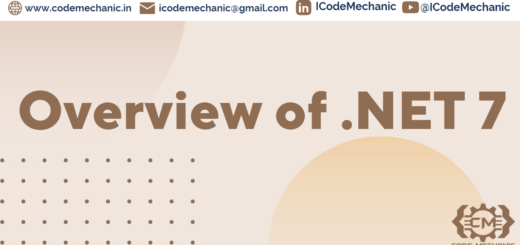Mastering Exception Handling in C#
Exception handling is a crucial aspect of software development, ensuring that your application gracefully handles unforeseen errors and exceptions. In C#, a powerful programming language widely used for building various types of applications, exception handling plays a vital role in writing robust and reliable code. In this blog post, we’ll explore the fundamentals of exception handling in C# and delve into best practices to effectively handle and manage exceptions.
What are Exceptions?
In simple terms, an exception is an abnormal condition or error that occurs during the execution of a program. These exceptions can arise due to various reasons, such as invalid input, resource unavailability, file I/O errors, or network failures. By handling exceptions, you can prevent your application from crashing and provide a controlled response to such exceptional conditions.
Exception Handling Mechanism in C#: C# provides a comprehensive mechanism for handling exceptions through a combination of try, catch, and finally blocks. Here’s how it works:
- Try Block: The try block encapsulates the code that might raise an exception. It defines the section of code where you anticipate the occurrence of an exception.
- Catch Block: The catch block follows the try block and specifies the type of exception it can handle. When an exception is thrown within the try block, the catch block with the matching exception type is executed. Multiple catch blocks can be chained together to handle different types of exceptions.
- Finally Block: The finally block, if present, is executed regardless of whether an exception is thrown or caught. It is commonly used to perform cleanup operations or release resources used within the try block.
Exception Handling Example: Let’s consider a simple example to illustrate exception handling in C#:
try
{
// Code that might throw an exception
}
catch (ExceptionType1 ex)
{
// Handle ExceptionType1
}
catch (ExceptionType2 ex)
{
// Handle ExceptionType2
}
finally
{
// Cleanup operations
}Best Practices for Exception Handling in C#: To effectively handle exceptions in C#, consider the following best practices:
- Be specific in catching exceptions: Catch only the specific exceptions that you can handle and let others propagate up the call stack. This approach helps maintain code clarity and ensures that exceptions are appropriately handled.
- Use finally block for resource cleanup: The finally block is a great place to release resources like file handles, database connections, or network sockets. Even if an exception occurs, the finally block will be executed, allowing for proper resource cleanup.
- Log exceptions: Logging exceptions provides valuable information for troubleshooting and debugging purposes. Consider using a logging framework (e.g., NLog, log4net) to capture exception details along with contextual information.
- Avoid catching generic exceptions: Catching generic exceptions like
Exceptionshould be avoided whenever possible. It can make it harder to identify and fix specific issues within the code. - Handle exceptions close to the source: Catch exceptions as close to the source as possible, rather than letting them propagate up the call stack without any meaningful handling. This approach helps in pinpointing the exact location of the exception and providing context-specific error messages.
- Use try-catch-finally sparingly: While exception handling is essential, it’s important to use try-catch-finally blocks judiciously. Overusing them can lead to verbose and cluttered code. Consider handling exceptions only when necessary and allowing higher-level components to handle exceptions appropriately.
In addition to the fundamental exception handling mechanism, C# provides the Exception class as a foundation for creating and handling exceptions. The Exception class is a part of the System namespace and serves as the base class for all exceptions in C#. Here’s an explanation of the Exception class and its key members:
- Message: The Message property of the Exception class represents a descriptive message that provides additional information about the exception. It helps in understanding the cause of the exception and can be accessed using the
Messageproperty. - StackTrace: The StackTrace property contains a string representation of the call stack at the point where the exception was thrown. It helps in tracing the sequence of method calls that led to the exception. The StackTrace property is commonly used for debugging and logging purposes.
- InnerException: The InnerException property gets the Exception instance that caused the current exception to be thrown. It allows for chaining exceptions together to provide a more comprehensive error context. By accessing the InnerException property recursively, you can traverse the exception chain and understand the complete error history.
- HelpLink: The HelpLink property represents a URL or a path to a help file associated with the exception. It can be used to provide additional resources or documentation to help understand and resolve the exception.
- Source: The Source property gets or sets the name of the application or the object that caused the exception. It helps in identifying the source of the exception, especially when multiple components or modules are involved.
- GetType(): The GetType() method returns the runtime type of the current instance of the Exception class. It allows you to programmatically determine the specific type of the exception and perform additional actions based on that information.
- ToString(): The ToString() method returns a string representation of the current exception object. It combines the exception type, message, and stack trace, providing a comprehensive textual representation of the exception.
Derived Exception Classes: Apart from the Exception class, C# provides various derived exception classes that specialize in different types of exceptions. Some commonly used derived exception classes are:
- ArgumentException: Represents errors that occur when one or more arguments provided to a method are invalid.
- ArgumentNullException: Thrown when a null argument is passed to a method that does not accept null values.
- InvalidOperationException: Represents an exception that is thrown when a method is called in an invalid state.
- IOException: Represents errors that occur during input/output operations, such as file or network-related operations.
- DivideByZeroException: Thrown when a division or modulo operation is performed with zero as the divisor.
Custom Exception Classes: In addition to using the built-in exception classes, you can also create your own custom exception classes by deriving from the Exception class. Custom exception classes allow you to define application-specific exceptions that provide meaningful context and help in better error handling and recovery.
Exception handling is a critical aspect of writing reliable and robust applications in C#. By understanding the exception handling mechanism and following best practices, you can effectively handle exceptions, ensure graceful error recovery, and provide a smoother user experience. Remember to be specific in catching exceptions, use the finally block for cleanup




